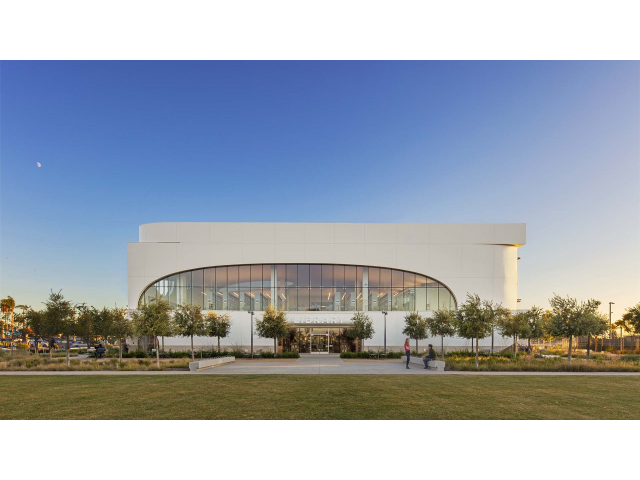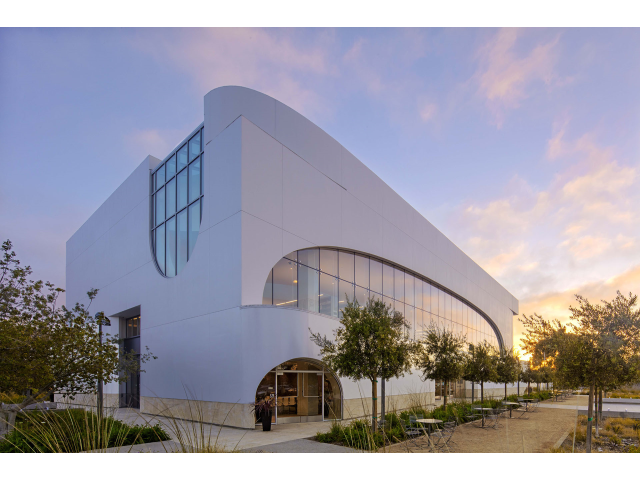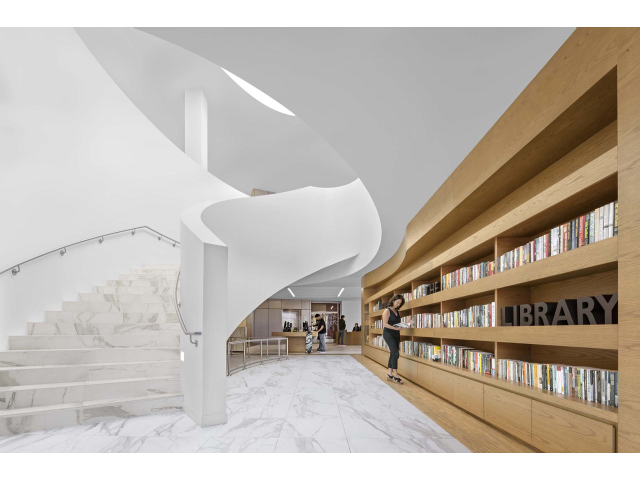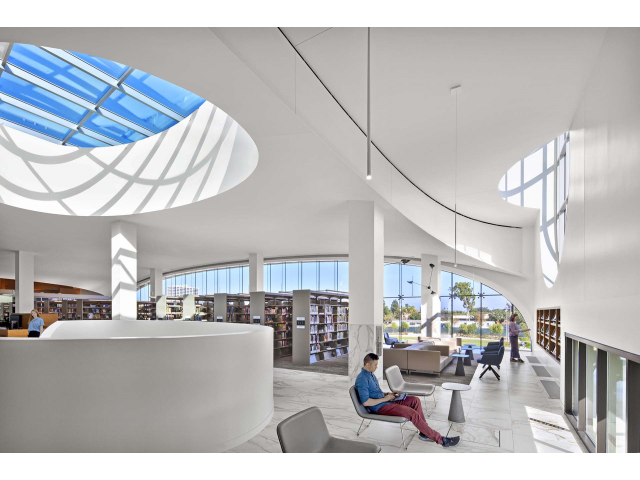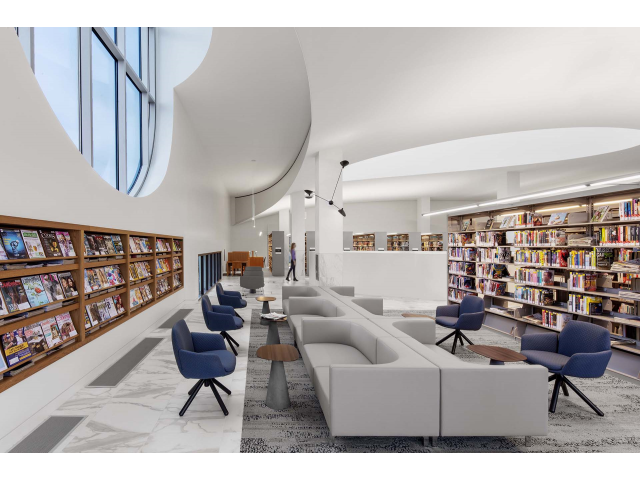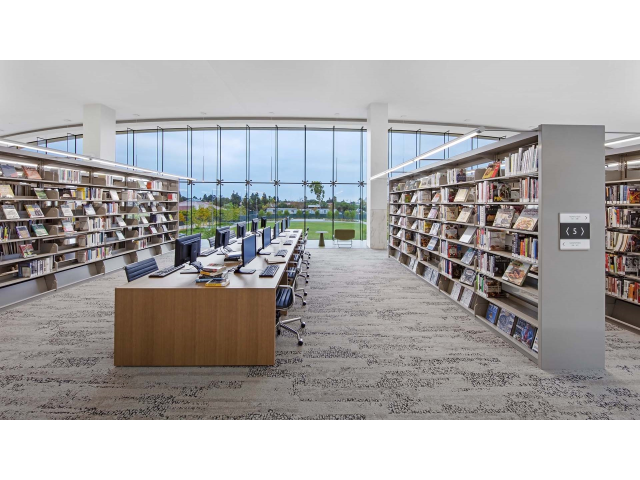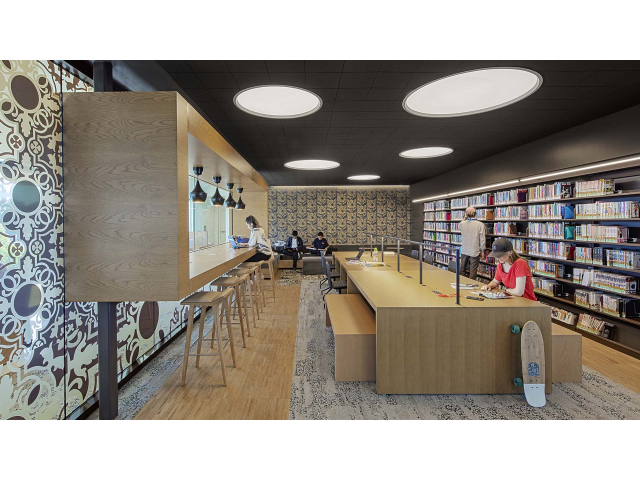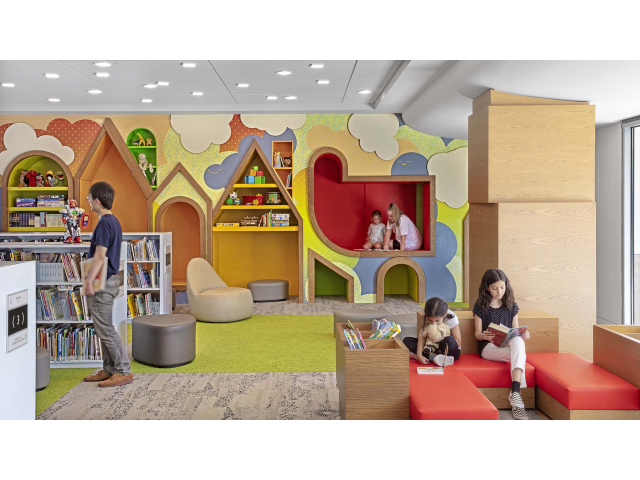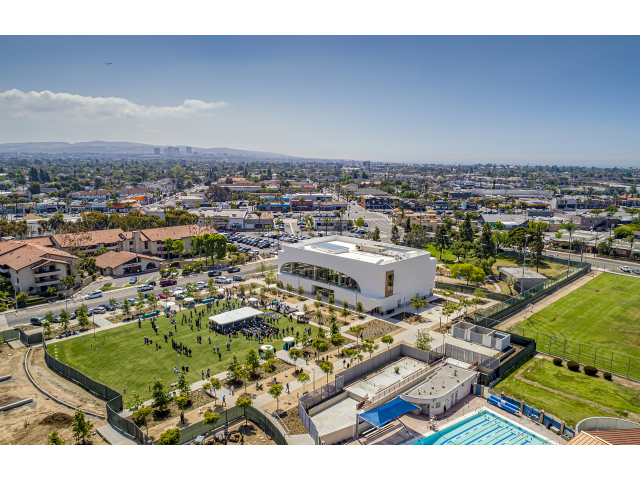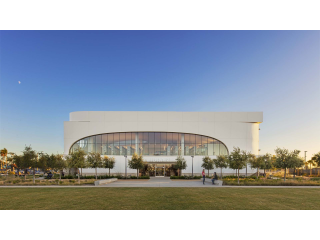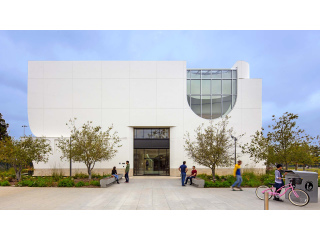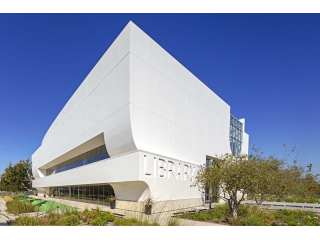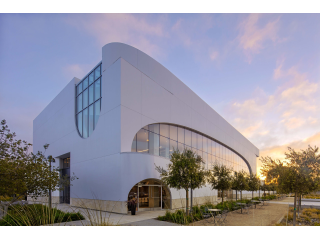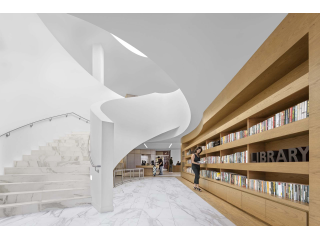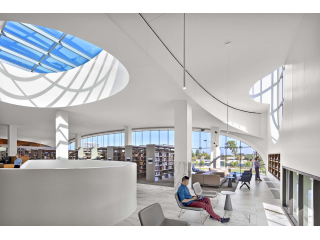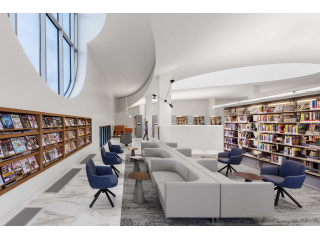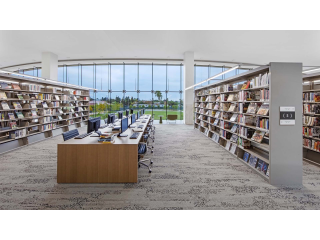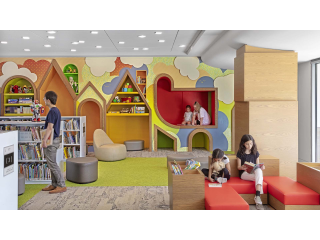Project Data:
Completion Date: 2/3/2020
Square Footage: 22500
Building Use: Library | Program includes two community meeting rooms, the market-place/popular library, Friends-of-the-Library bookstore, young adult library, children’s library, study rooms, readers seats and collections.
Project Description:
In its own regard, the new Donald Dungan Branch Library in Costa Mesa is a project worth recognition with its design that channels flamboyant mid-20th century modernist architecture, while also looking back several hundred years to the austere beauty of California’s missions, models of exuberant yet restrained grandeur accomplished with economical means. But when evaluated within the context and setting of the multi-phase Lions Park Redevelopment -- the interrelationship between building and site -- the impact of the project can fully be observed.
The library serves as the centerpiece of the 10-acre park which has enlivened the surrounding community through an increase in programming for learning, recreation and community engagement. While initial plans called for the demolition of the former library, our architects saw the potential and value in transforming the space into a new community center. The new library and park includes the renovation of the former 8,000 SF circular library as a new community meeting center with seating for up to 300 people and a 100-seat event space for dinners, receptions and other similar events. The compact two-story configuration yielded a net increase of one acre of park space in this dense urban neighborhood. The park is an extension of library programming, offering space for book fairs, outdoor movie screenings, and markets, as well as a space to read, work, and socialize.
Verticality of the library design placed an emphasis on how programs and activities are zoned. The first floor is the hub of the active community library housing two community meeting rooms, a marketplace, the friends of-the-library bookstore, and the children's library. The second floor is a place of quiet concentration, reflection, study and displays the vision of civic grandeur reminiscent of great readings rooms of libraries of the early 20th century but done in a contemporary way. It features expansive views of the park and a “balloon vault” ceiling and was designed to allow a large capacity of visitors inside without feeling compact. Programs on the second floor include the library offices, study rooms, technology stations and a teen reading area.
The building is encased in concrete plaster, which creates a luminous, white surface reminiscent of mission style architecture, with light porcelain printed tiles encircling the perimeter of the structure adjoining the concrete to the ground. The designers sought to apply these “humble” materials to a large scale to give the civic building a sense of recognizable stature to a community familiar with California missions, while bringing in modern elements relevant for years to come. Of these contemporary forms are three curved window cut-outs on the second floor which allow natural daylight to enter the main reading room, connecting the library interior to views of Lions Park beyond.
The project originally targeted LEED Silver certification but was able to achieve LEED Gold for both the new library and renovated community center. Sustainable features of the design and construction include the optimized building orientation, construction waste management, stormwater control, use of daylight and design for thermal comfort.
Firm Name: Johnson Favaro
Completion Date: 2/3/2020
Square Footage: 22500
Building Use: Library | Program includes two community meeting rooms, the market-place/popular library, Friends-of-the-Library bookstore, young adult library, children’s library, study rooms, readers seats and collections.
Location: Costa Mesa, CA
Project Description:
DESIGN FOR EQUITABLE COMMUNITIES
The investments in the park have turned a critical neighborhood resource that has endured years of benign neglect into a vibrant new social landmark in the community. Residents who for years chose to use libraries in neighboring cities, now walk to their new library. The new park improvements that surround the library extend the life of the library outdoors and as well have sponsored new outdoor recreation and cultural programming.
The number of reader seats in the new library tripled as compared to the existing library. One of the community meeting rooms serves often as a makerspace for all ages, something that was not accommodated in the existing library. Attendance at the new library has quadrupled.
The new park is an extension of library programming providing shaded outdoor reading gardens and plentiful seating for work, study and social gathering. The great lawn and surrounding promenades also host event space for book fairs, outdoor movie screenings, theater-in-the-park, as well as providing a new venue for farmers’ and craft markets.
DESIGN FOR RESOURCES
Aspects of our design and construction strategy brought new life to existing materials. An alternative investigation by our construction managers found that construction materials reclaimed from the community center’s demolition could be repurposed as the 10-foot-deep crushed material base for the new library’s foundation. This unique method minimized waste and reduced the amount of construction debris that needed to be hauled off site.
Optimized building orientation and placement of the long broad window facing north allows the library to use daylight to provide most of the daytime lighting for the building. Other sustainable design methods included the use of low-emitting materials to reduce Volatile Organic Compounds (VOCs) from polluting the air, state-of-the-art LEED light fixtures to save electrical energy consumption, low-flow fixtures to conserve water, and white thermoplastic polyolefin roofing membrane to reduce the heat island effect and reduce costs. Additionally, an accessible raised flooring system passively heats and cools the building, naturally circulating air from below each floor plenum and venting out through the oval skylight above. Enhanced commissioning was contracted on all electrical, lighting and HVAC equipment to ensure all functional-performance and Testing & Air Balance (TAB) were completed and accepted along with Cx owner training. Ensuring systems work properly early on helps to prevent potential maintenance costs in the future.
DESIGN FOR WELLNESS
Increased visibility and strategic building orientation works to benefit park and library visitors by improving safety and security. During the planning stages of the project, our architects pointed out to the city that the existing position of some of the buildings in the park and their orientation created blind pockets. Since there were areas where no lines of site from active community buildings or outdoor programming, there was a history of issues connected with security in the park. The reading room and its primary north facing windows serve two functions: one is seeing out and letting light in, but the other is the ability for people to see a busy, active community library, seeing people enjoying themselves inside. Service desks were placed at the center of both first and second floors to also maximize sightlines and allow librarians and other staff members to serve their role as a source of valuable information for library patrons.
Our architects maintain the idea of democratizing light in view – providing it to the greatest number of people. As such, we placed library offices inward from the building perimeter and use glass walls so people inside the office can still enjoy light. Visitors can then enjoy the reading areas placed around the perimeter windows.
Greater interior comfort is provided to library patrons by using the raised floor system with mechanical equipment beneath the floors. The conditioned air is delivered at floor level rather than supplied from distant ceiling mounted registers. A lower volume of air moves more naturally from the ground and drifts upward.
Community wellness was also considered during demolition of the existing Neighborhood Community Center. An extraordinary effort was made to contain concrete and silicon dust within the construction site so the material did not create fugitive dust that would contaminate the adjacent community swimming pool and disturb the nearby gymnasium.
DESIGN FOR WATER
A combination of native landscaping, bioswales, increased permeable ground and low flow bathroom fixtures ensures sustainable water use for the project. Redevelopment of the park included replacing the existing neighborhood community center parking lot with a new 1-acre grass lawn, native drought tolerant landscaping and water conserving drip irrigation system. Bio-filtration planters flank the new library park open space and conduct stormwater to inlets piped to a new ground water infiltration system. All surface storm water on the project site drains to large underground storage tanks that allow the storm water to percolate down to the aquifer with no water flowing off site.
Permeable ground plane area totaled about 60% of the park’s 10 acres. The remainder was either covered with surface parking, paving or buildings. Consolidating the building footprint of the new library, removing an oversized community center, re-purposing the former library as the new community center, and using permeable surfaces where possible, increased permeable ground plane.
Design Architect:
Johnson Favaro
Associate Architect or Firm:
Steve Johnson, AIA
James Favaro, AIA
Landscape Architect:
Office of James Burnett
Owner / Developer:
City of Costa Mesa
County of Orange
Orange County Public Libraries
Engineer:
KPFF Consulting Engineers - Civil Engineers
Nabih Youssef Associates - Structural Engineers
Integral Group - MEP Engineer
Geotechnologies - Geotechnical Engineer
General Contractor:
Tovey Schultz
Consultant:
Linda Demmers - Library Consultant
STV - Construction Management
Arup - Enhanced Commissioning
Dotrio Inc. - Interior Design
Darkhorse Lightworks - Lighting Design
Environmental Graphics - Ph.D
Waveguide - AV/IT Design
MGAC - Cost Estimation
TRC Consultants - Specifications
Secure Consulting & Design - Security
Yamada Enterprises - Furniture Dealer, Shelving Consultant
Photographer:
Eric Laignel (Images #1-11)
Jeff Durkin (Image #12)
Costa Mesa-Donald Dungan Library
Category
Commercial > Built
Winner Status
- Merit Award
